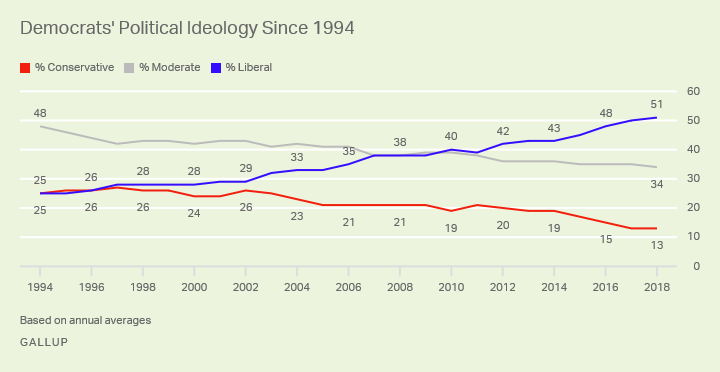In Defying the Odds, we discuss the Sanders candidacy and the leftward drift of the Democratic Party.
Mike Allen at Axios:
Mike Allen at Axios:
President Trump redefined mainstream conservatism. Now, a cast of rising Democratic stars and 2020 candidates are redefining mainstream liberalism.
You see it in many of the major domestic debates of our times, Axios' Jim VandeHei points out:Lydia Saad at Gallup:
- Support for a big government "Green New Deal" to fight climate change. Watch the 2020 candidates jump on this bandwagon.
- Support for Medicare for All, calling for a much bigger government role in health care, beyond the Affordable Care Act.
- A rush away from tough-on-security as crucial to immigration reform, which until recently was seen by most Democrats as essential to not looking soft on crime or terrorism.
Americans' assessment of their political ideology was unchanged in 2018 compared with the year prior when 35% on average described themselves as conservative, 35% as moderate and 26% as liberal. Although conservatives continue to outnumber liberals, the gap in conservatives' favor has narrowed from 19 percentage points in Gallup's 1992 baseline measurement to nine points each of the past two years.
Since 1992, the percentage of Americans identifying as liberal has risen from 17% then to 26% today. This has been mostly offset by a shrinking percentage of moderates, from 43% to 35%. Meanwhile, from 1993 to 2016 the percentage conservative was consistently between 36% and 40%, before dipping to 35% in 2017 and holding at that level in 2018.
These ideology figures are based on combined data from Gallup's monthly GPSS and other standalone surveys conducted each year. The 2018 aggregate includes 13 surveys totaling more than 13,000 national adults.
The percentage of Democrats identifying as liberal averaged 51% in 2018, up from 50% in 2017, marking the first time a majority of Democrats have adopted this term, following gradual increases since the 1990s.
